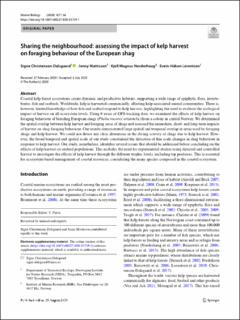Sharing the neighbourhood: assessing the impact of kelp harvest on foraging behaviour of the European shag
Peer reviewed, Journal article
Published version

Åpne
Permanent lenke
https://hdl.handle.net/11250/2675823Utgivelsesdato
2020Metadata
Vis full innførselSamlinger
- Publikasjoner fra CRIStin - NINA [2364]
- Scientific publications [1392]
Originalversjon
10.1007/s00227-020-03739-1Sammendrag
Coastal kelp forest ecosystems create dynamic and productive habitats, supporting a wide range of epiphytic flora, invertebrates, fish and seabirds. Worldwide, kelp is harvested commercially, affecting kelp-associated animal communities. There is, however, limited knowledge of how fish and seabird respond to kelp harvest, highlighting the need to evaluate the ecological impact of harvest on all ecosystem levels. Using 6 years of GPS-tracking data, we examined the effects of kelp harvest on foraging behaviour of breeding European shags (Phalacrocorax aristotelis) from a colony in central Norway. We determined the spatial overlap between kelp harvest and foraging areas of shags and assessed the immediate, short- and long-term impacts of harvest on shag foraging behaviour. Our results demonstrated large spatial and temporal overlap in areas used by foraging shags and kelp harvest. We could not detect any clear alterations in the diving activity of shags due to kelp harvest. However, the broad temporal and spatial scale of our study constrained the detection of fine scale changes in shag behaviour in response to kelp harvest. Our study, nonetheless, identifies several issues that should be addressed before concluding on the effects of kelp harvest on seabird populations. This includes the need for experimental studies using directed and controlled harvest to investigate the effects of kelp harvest through the different trophic levels, including top predators. This is essential for ecosystem-based management of coastal resources, considering the many species composed in the coastal ecosystem.